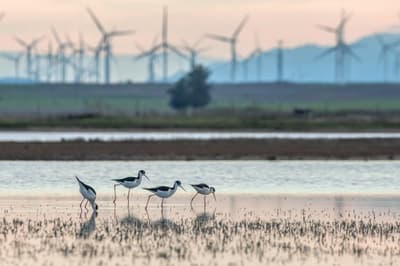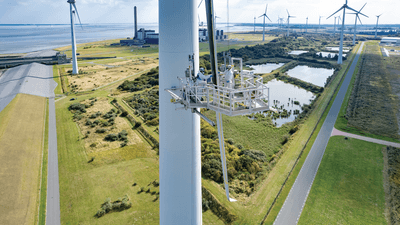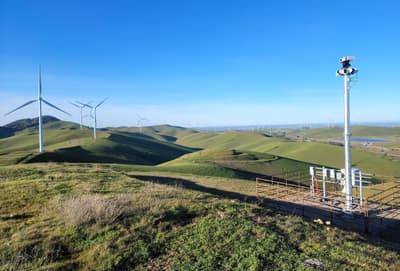Some companies are rolling out radar and cameras linked to A.I. that will shut down turbines when birds fly too close.
But scientists and entrepreneurs are finding ways of reducing these conflicts. They are researching bird behavior near turbines and devising and testing new technologies to keep birds safe. Some potential solutions are simple, like painting turbine blades in contrasting colors. Others are complex and expensive, like using cameras with A.I. technology to shut turbines down when birds approach. Although progress on solutions has been uneven, most researchers and conservationists believe that if the wind industry takes birds seriously — a big “if” because only some operators currently do — the conflicts can be significantly reduced.
It can be hard to understand why birds fly into wind turbines. On a clear day they’re obvious to human eyes from miles away. Why do eagles, for example, collide with turbines even though their large eyes resolve far finer details at much greater distances than ours do? Graham Martin, a bird vision expert at the University of Birmingham, says that birds don’t see the world as humans do, and different species of birds see the world differently from each other.
Small songbirds usually have all-round vision, while “large-eyed birds tend to have a blind area above their heads,” he says. Birds like eagles and vultures “spend a lot of time flying at reasonable altitudes, not particularly high, looking at the ground” for food, so “they’re effectively flying blind.” Many species have not evolved behaviorally to regularly look ahead in their direction of travel, he says, because their ancestors have for millions of years “flown in open airspace where there’s never been anything [like a wind turbine] intruding.”
Black-necked stilts near a wind farm in Solano County, California. Anton Sorokin / Alamy Stock Photo
Many bird species are also less able than humans to detect contrast. Turbines are often painted white or pale gray to be less visually intrusive to humans, but that can make them harder for birds to see against the sky. Martin says that ducks and geese often fly at high speed in low light — before dawn and at twilight — or in foggy weather. Although they have good forward vision, their habit of flying fast in low-visibility conditions places them at risk. And small songbirds often migrate at night, adding another layer of complexity to the problem.
One thing is clear from the growing body of research on wind turbines and birds: The impacts of these machines vary by place, time, and species of bird. Some wind farms kill large numbers of birds; others do not. Some types of birds, like gulls, are killed at some wind farms and not at others; researchers don’t always know why. Corvids — crows, ravens, and their relatives — generally do not collide with wind turbines, while birds of prey often do. Weather conditions and surrounding habitats also influence the effects of turbines; for example, turbines on the Dutch coast, which hosts high concentrations of migratory species, kill many more birds than inland turbines do.
Wind farms in South Africa already kill an average of 3.8 endangered black harriers per year, a rate that must be reduced.
The Smøla Wind Farm consists of 68 turbines on an island off the Norwegian coast. It was completed in 2005, and researchers began using trained dogs to search for dead birds under its turbines in 2006. Over the following six years, the dogs found dozens of carcasses, including those of six white-tailed eagles, which are legally protected in Norway. Then, in 2013, ornithologists led by Roel May of the Norwegian Institute for Nature Research selected four bird-killing turbines and painted one blade of each black, a color that earlier lab experiments had indicated would be highly visible to raptors. They left four neighboring turbines that had also killed birds unchanged as experimental controls.
The Smøla researchers continued recording dead birds until the end of 2016, when they found that overall bird deaths at the black-bladed turbines were more than 70 percent lower than at control turbines, and that the black-bladed turbines had killed no white-tailed eagles. Their data, published in 2020, received global media attention: Perhaps a simple coat of paint could solve this problem?
In 2021, inspired by the Smøla work, researchers began documenting bird collisions at 14 turbines at Eemshaven, on the Dutch coast. The turbines are situated in an area with high bird traffic, between wetlands, agricultural fields, and industrial sites. In 2022, one blade on each of seven turbines was painted black, and the collision monitoring continued. The outcomes so far have been disappointing; there has been no large reduction in bird fatalities at the black-bladed turbines.
Eric Klop, a Dutch ornithologist who has worked at Eemshaven, tells Yale Environment 360 that perhaps black blades don’t stand out against the nearby industrial landscape as well as they do against an often-snowy Norwegian island. And Eemshaven birds may have become accustomed to vehicle activity and are therefore less sensitive to movement than birds in rural Norway.
Another blade-patterning experiment, halfway around the world, is showing promise, though. In South Africa, several bird species are at significant risk from wind farms, among them the endangered black harrier, a striking, medium-sized raptor with a declining population of fewer than 1,300 birds. A recent study estimates that a loss of just three to five adults per year will drive the species extinct in less than a century. BirdLife South Africa research shows that wind farms already kill an average of at least 3.8 black harriers per year, a rate that must be reduced.
The Hopefield wind farm, north of Cape Town, is known to kill 10 species of raptors, including black harriers. In early 2023, University of Cape Town ornithologist Rob Simmons selected 20 turbines within the wind farm for an experiment. He arranged for one blade on each of four particularly lethal turbines to be painted with broad red bands, leaving the remaining 16 turbines as controls. (He’d wanted black, but South African aviation safety authorities allowed only signal red.)
In Africa, some wind farms rely on human observers to shut down individual turbines when at-risk birds approach.
Bird deaths at Hopefield were monitored for 24 months before painting and 24 months after. According to Simmons, bird deaths went down by more than 80 percent at the four red-banded turbines, with the control turbines showing much less of a reduction. Significantly, Simmons says, the patterned turbines have killed only one bird of prey since painting, compared to seven before painting.
Graham Martin, the vision expert, says that the most effective pattern for making turbines maximally visible to the widest range of birds would likely be broad black and white stripes across blades and on the tower — although this might be visually annoying to people and is prohibited by aviation rules in some countries. Like others interviewed for this article, he emphasizes that more research on blade patterning must be done to establish its efficacy in different contexts.
Another way to reduce bird deaths at turbines is to stop or slow blade rotation when birds are nearby, a process called “bird curtailment.” Turbines can be shut down for days or weeks when, for example, large numbers of birds are expected to be migrating through or breeding in an area. If a specific at-risk bird (like a low-flying eagle) is passing nearby, the turbines can be stopped or slowed for just a few minutes, a process known as “shutdown on demand.”
A monitoring system (right) uses A.I. to determine if birds are in danger of colliding with turbines in Alameda County, California. IdentiFlight
Longer-duration bird curtailment is not popular among wind farm operators as it can significantly reduce their income, but it’s been identified as a vital strategy to protect migratory birds. Project Start/Stop in the Netherlands aims to protect birds while minimizing turbine downtime. Its predictive models combine bird radar and weather data to finely forecast peak bird migration periods and shut down offshore turbines when large numbers of migrants are flying over the North Sea, as millions do every spring and autumn.
Shutdown on demand of individual turbines usually results in far less generation loss than longer-term curtailment, but it can be more technically challenging to implement. A large shutdown on demand project in Spain, which covered 269 turbines at 20 wind farms, dropped mortalities of large soaring birds like storks and raptors by more than 60 percent but cut energy production by only 0.51 percent.
In Africa, where labor costs are low, a small number of wind farms are using human observers to monitor bird movement and shut down individual turbines when at-risk birds approach. The Excelsior Wind Farm in South Africa, for example, has used this technique to completely eliminate mortality of large birds of prey while losing less than 1 percent of energy production, although two fast-flying, harder-to-see black harriers have been killed there.
A.I. systems must be trained on specific species at specific sites — this takes months or years and can be expensive.
In places with high labor costs, like Europe and North America, companies are rolling out high-resolution radar and cameras linked to artificial intelligence image analyzers to detect birds and automatically shut down turbines when they fly too close. Different systems have different strengths. Radar can’t normally identify birds to species level, but it can tell large birds from small and operate around the clock and in inclement weather. A.I.-supported camera systems can be trained to identify species, but they don’t work well in poor weather or at night. Jonne Kleyheeg-Hartman, a Dutch ornithologist with experience in these systems, says that A.I. camera systems must be trained on specific species at specific sites — this takes months or years and can be expensive, which currently limits their utility.
Longer-term curtailment and shutdown on demand can hugely reduce bird deaths at wind farms, experts say, but there is currently insufficient regulatory pressure in many parts of the world to push operators to use these methods.
Experts agree that the most important factor in determining how dangerous a wind turbine will be to birds is its location. They say turbine site selection should include close study, for several years, of how birds use an area before a project moves forward, but this often is not done due to pressure from investors to speed projects along or the lack of enforceable laws. Roel May says the key to building bird-friendly wind farms is clear regulation: Governments must ensure that impacts on birds are researched in advance, monitored during operation and, if necessary, reduced, as they increasingly are in some European countries.
“If you’re painting blades black or doing curtailment that means you know you have a problem,” says May — a problem that could have been avoided by placing turbines elsewhere. He says that in many countries, wind developers consider social and environmental impacts only after they’ve settled on sites with good wind and access to electricity distribution networks, which is too late. “The more research you do early in the planning process, the better.”






